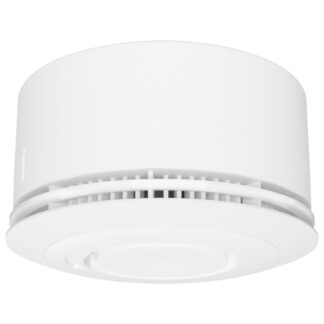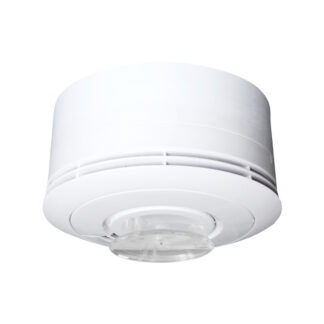
When it comes to ensuring the safety of your home or workplace, early detection of fires is paramount. Smoke detectors and heat detectors are two common types of fire detection devices that play a crucial role in fire prevention and life safety. While these fire detecting devices share the same overarching goal of alerting occupants to the presence of a fire, they operate on different principles and have distinct applications.
In this article, we will explore the key differences between smoke detectors and heat detectors to help you make informed choices for your fire safety needs. Towards the conclusion, we will showcase our Mobeye smoke and heat detectors.
Table of contents
- Differences Between Smoke Detectors and Heat Detectors
- Sensing Mechanism
- Response Time
- False Alarms
- Ideal Use Cases
- Conclusion
- Mobeye Fire Alarms
Differences Between Smoke Detectors and Heat Detectors
Smoke and heat detectors operate on fundamentally divergent mechanisms. Smoke detectors discern the presence of smoke particles, while heat detectors respond judiciously to elevated temperatures.
1. Sensing Mechanism
Smoke Detectors
Smoke detectors operate by sensing the presence of smoke or particulate matter in the air. They are equipped with sensors that can detect tiny smoke particles or aerosols produced by combustion. When these sensors detect smoke, the alarm is triggered, alerting occupants to the potential fire. Smoke alarms are highly effective at detecting fires in their early stages, even before the flames become significant.
Heat Detectors
Heat detectors, on the other hand, rely on temperature as their primary sensing mechanism. They are designed to activate when the surrounding temperature rises above a certain threshold. This threshold is typically set at a temperature significantly higher than normal room temperature. Heat detectors are better suited for environments where the presence of smoke is common, such as kitchens or industrial settings, as they are less likely to produce false alarms in such conditions.
2. Response Time
Smoke Detectors
Smoke detectors are known for their quick response to fires. They can detect smoke as soon as it enters their sensing chamber, making them highly effective in alerting occupants to early-stage fires. This swift response time can be critical in preventing fire-related injuries and minimising property damage.
Heat Detectors
Heat detectors, while reliable, may not provide as rapid a response as smoke detectors. They typically activate when the temperature reaches a certain threshold, which means they are better suited for detecting fires in the later stages when flames and heat are more pronounced. This characteristic makes them valuable in locations where early detection might not be as critical, such as garages or storage areas.
3. False Alarms
Smoke Detectors
One drawback of smoke detectors is that they can be susceptible to false alarms. They may trigger if dust, steam, or cooking fumes enter their sensing chamber. To mitigate this, some modern smoke alarms come equipped with advanced algorithms and features to reduce false alarms.
Heat Detectors
Heat detectors are less prone to false alarms caused by non-fire-related elements since they do not respond to smoke or airborne particles. However, they are not immune to false alarms triggered by high-temperature conditions unrelated to a fire. For instance, a heat detector in a poorly ventilated room with extreme heat may activate erroneously.
Ideal Use Cases
Smoke detectors and heat detectors have different applications. Examples are:
Smoke Detectors
- Residential homes
- Bedrooms
- Hallways
- Living rooms
- Commercial buildings
- Offices
- Hospitals
Heat Detectors
- Kitchens
- Garages
- Stables
- Industrial facilities
- Areas with high dust or smoke production
Conclusion
In summary, smoke detectors and heat detectors serve distinct purposes in fire detection and safety. Smoke detectors are excellent for early-stage fire detection, providing rapid alerts to the presence of smoke or combustion particles. On the other hand, heat detectors are better suited for environments where smoke is common and rapid temperature increases are a more reliable indicator of fire.
Ultimately, the choice between smoke and heat detectors depends on your specific needs and the environment in which they will be installed. Many modern fire safety systems incorporate a combination of both types to provide comprehensive protection. Regular maintenance, testing, and adherence to local building codes and regulations are essential to ensure that these devices function effectively when needed most. Investing in the right fire detection system can be a lifesaver and help protect your property from devastating fire damage.
Mobeye Fire Alarms
Mobeye fire alarms not only sound the alarm, but also send a fire alarm notification to your smartphone, via the Mobeye Messages App (iOS/Android), or as phone call, text message and/or email.
Discover our collection:
-
 Mobeye 4G Smoke Detector CM4400, Battery Powered€ 259,00 (€ 214,05 excl. VAT)
Mobeye 4G Smoke Detector CM4400, Battery Powered€ 259,00 (€ 214,05 excl. VAT) -
 Mobeye Heat Detector w/ RF Module CM4400H-RF€ 399,00 (€ 329,75 excl. VAT)
Mobeye Heat Detector w/ RF Module CM4400H-RF€ 399,00 (€ 329,75 excl. VAT) -
 Mobeye Heat Detector CM4400H, with alarm notification€ 302,50 (€ 250,00 excl. VAT)
Mobeye Heat Detector CM4400H, with alarm notification€ 302,50 (€ 250,00 excl. VAT)

 Finding the ideal product to meet your project needs can be challenging. We have organised our products by application to simplify your decision-making process. To access a list of related products, please click on the relevant application field.
Finding the ideal product to meet your project needs can be challenging. We have organised our products by application to simplify your decision-making process. To access a list of related products, please click on the relevant application field.

